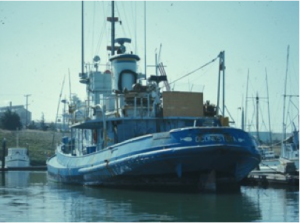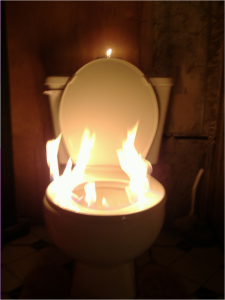By Kenneth and Susan Coale (15 September 2015)
When John Martin came to MLML in 1973, he brought with him an interest in oceanography that stretched the capacity of the MLML fleet. Several high profile grants with prominent scientists, both national and international, brought vigor and national recognition to the study of metal and nutrient cycling, well beyond the bounds of California’s 3-mile limit. With an expanding program in Oceanography at MLML, the Marine Laboratories were rapidly outgrowing the meager and primitive accommodations of the R/V Oconostota, a converted ocean-going tug boat, more affectionately known as the Rolly “O”.

The R/V Oconostota was a “gift” from Scripps Institution of Oceanography, yet due to it’s inherent unseaworthiness, propensity for violent rolls and a nefarious captain, John Martin was looking for another vessel and an upgrade to the oceanographic profile of the MLML fleet. Having been recently installed as the Labs’ Director, and also holding a new position on the UNOLS Council, John had a bird’s eye view of the entire US research fleet. He had recently sailed aboard the R/V Cayuse out of Oregon State University (OSU) in a crossing from Honolulu to Moss Landing in the summer of 1977, and was thinking this kind of vessel could be a good replacement. When OSU took possession of the newly built R/V Wecoma, MLML was able to bid successfully for the acquisition of the R/V Cayuse. This is an example of institutional positioning. John always positioned MLML in the waste stream of other, richer institutions, and in that position, shit happens! MLML proudly took possession of the R/V Cayuse in 1979 and by the early 1980s John and his group were deep into the CEROP (NSF, Chemical Exchange Rates with Oceanic Particles, with UCSC) and VERTEX (NSF, Vertical Transport and Exchange) programs with many collaborators.
The Oregon State University named many of their vessels after American Indian features and peoples of their region and MLML did not discover until later, that the word “Cayuse” also meant “bucking horse”. The R/V Cayuse was not originally built as a research vessel, few boats were in those days. She was a fishing boat with a large empty front hold with a hundred tons of buoyancy. The staterooms and heads were installed there. She was known for being “lively”. Not only could she jump and buck, she could pitch, roll, yaw, lurch and kick. Even under calm conditions, many “blew their cookies” and pitched their lunch, breakfast and dinner across her rails. We found out later that OSU knew about this ride, in fact there had been a few instances where the mates on watch actually passed out on the bridge. A doctor was called in to evaluate the vessel and measured acceleration forces in excess of 2 g’s when the ship would right itself while rising from the trough of a swell. The crew were blacking out due to the type of g-force hypotension normally experienced by jet pilots wearing compression suits and breathing oxygen. The R/V Cayuse, however, was not so provisioned, but we were not to look a gift horse in the mouth.

With increasing oceanographic activity, a steady stream of students and technicians set to sea aboard the R/V Cayuse to sample water, plankton and sinking particulate matter. Free-floating sediment traps, known as PITS (Particle Interceptor Traps), were deployed and followed for days to measure carbon flux. Water samples were spiked with 14C to measure primary production. Chlorophyll, nutrients, salinities, oxygens, were all measured on board, while trace metal samples dripped through Chelex columns and PIT samples sloshed back and forth in their petri dishes under the dissecting microscope. The R/V Cayuse supported all of the activity of a vessel twice her size with half the people. Many students piled aboard and got their degrees using the data collected on these cruises, but even for the die-hard committed and determined researchers, these cruises were exhausting.
The vessel had been rode hard and put up wet, yet propulsion and engine control systems were basically sound and, aside from the normal winch and electronic demons that surfaced from time to time, the vessel was serviceable and compliant with Coast Guard standards…except for one thing. The State of California had established wastewater discharge criteria that were more stringent than the Oregon standards and within three miles from the coast the R/V Cayuse had only a few options to bring her waste treatment system into compliance: Hold it, Treat it, or Burn it. One problem was that the jurisdictional concept of the three-mile limit had recently been adjudicated in federal court. A suit brought by the fishing community contended that the limit should be 3 miles from shore, yet there are special considerations for bays and estuaries. The courts found that for Monterey Bay, the three mile boundary extended outside a line drawn between Point Santa Cruz to the North and Point Piños to the South, the entire bay was within the waste discharge restriction area as mandated by the California Department of Fish and Game. Because more and more of the research was conducted within the Bay and there were no pump-out facilities in Moss Landing at the time, engineering options were explored. The expansion of holding tanks was ruled out due to the fact that the hold was built out with staterooms and heads. The installation of a treatment plant was ruled out due to the lack of room in the engineering spaces for the bulky treatment units of the time, leaving incineration a promising alternative.
New stainless steel heads replaced the porcelain thrones. Accessory ventilation was installed and diesel fuel line extended from the engine room to the head and a spark plug was rigged in every unit. This seemed the kind of system that was designed with the exuberance and ingenuity of a mischievous 8 year old boy. Students Debbie Fellows, Susan Coale, Madeleine Urrere, Merrit Tuel, and Ginger Armbrust were accompanied by Technicians Sara Tanner and Craig Hunter with Researcher George Knauer on the maiden voyage of this new system. Their cruise plan called for 24/7 operations in Monterey Bay and offshore regions doing hydrocasts for seawater, tows for plankton, deployments of PITS and lots of shipboard analysis. Little did they know that those of salps, copepods and euphausiids were not going to be the only fecal pellets they would study on this voyage.

About day two out of the dock, the heads malfunctioned, about the same time that the crew’s initial constipation was beginning to ease. A flow of waste and vomit entered the new system. The engineer worked to free the clogs and adjust the fuel jets. There was some improvement, but maybe too much. The next person to the head, upon flushing, ignited the entire mass of debris. The load started burning and had to be subdued with a fire extinguisher. Smoke, flames and heat blackened the walls. It has been said that the next flush blew the entire contents out of the head, covering the walls, ceiling, and occupant, but this account may be more myth than fact. What is undeniable is that the heads filled with spew and scat in a swill of diesel fuel and toilet paper. The stench of diesel smoke and fumes, mixed with sewage, burnt and raw, filled the staterooms and the labs above, aggravating the nausea that was already setting in. Although the heads were never secured, the bowels of the scientists and crew stopped functioning for the remainder of the 5-day cruise. Some could relieve themselves over the side, others used a bucket, but this was dangerous on a pitching and rolling platform. People switched quickly to a liquid diet in spite of the sumptuous fare served up by the cook, MaryJoe. The officers together with the scientific party and crew soldiered on.
Upon docking in Moss Landing, the disembarkation was urgent and direct, still the mission was successful. As the story spread, a legend began to take shape and those participants and their super-human constitutions became unwitting celebrities. Tee shirts were silkscreened, memorializing the now famed “Flaming Heads Cruise”. In spite of this notoriety, the toilets were quickly remodeled, heads removed and a more conventional disposal system installed. All participants went on to promising careers and the story only buttressed Moss Landing’s reputation for producing some hard-core, bad-ass oceanographers. MLML has remained in the waste stream of some very renowned institutions and it has served us well, as several significant acquisitions have been realized in benefit of our students, staff and faculty. The R/V Cayuse continued in service of the UNOLS fleet for many years, only to be replaced by the more capable R/V Point Sur (formerly the R/V Cape Florida) from the University of Miami (another institution with a rich waste stream). Captain Don Bradford delivered the R/V Cayuse to a research consortium in the Gulf of Maine where the ship was renamed the R/V Argo Maine and Don sailed as Captain until retirement. Although John never looked a gift horse in the mouth, he paid more attention to the other end of the beast from then on.

